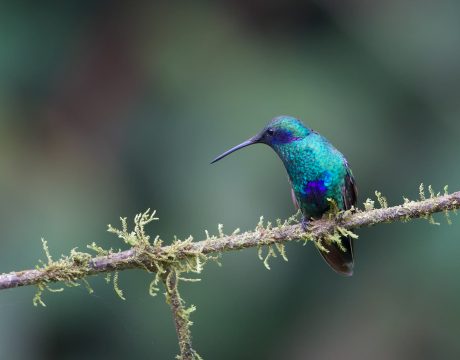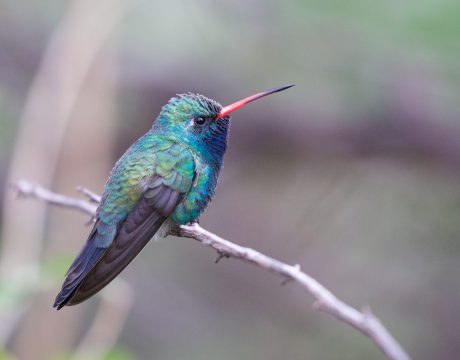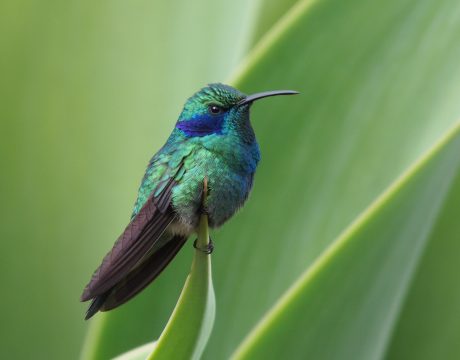Return of Bird of the Week: Sparkling Violetear
This is a larger cousin of the Lesser Violetear posted a few weeks back. The extensive violet-blue patch on the belly differentiates it from the other Violetears. It’s also distinguished by behavior: this species energetically defends blooming flowers from all other species of hummingbirds, butterflies and even bees. It’s the dominant species at most hummingbird feeders in its range. This species has an extensive range, extending from Panama to Argentina, generally at mid- to high elevations. WC has seen it at 11,500 feet, but it ranges higher. It adapts well to urban gardens and parks. Except when feeding hatchlings, this…
Return of Bird of the Week: Talamanca Hummingbird
When WC first saw this species, it was called Magnificent Hummingbird. But ornithologists decided to split Magnificent Hummingbird into two species. So the Costa Rican subspecies became the Talamanca Hummingbird, and the more northerly subspecies became Rivoli’s Hummingbird. There is officially no longer a species with the common name, Magnificent Hummingbird. Which is too bad, because this species is pretty magnificent. The new name comes from the Cordillera de Talmanca, one of two mountain ranges in which the bird is found. While the species reportedly “fairly common,” there is very little research on it or its cousin, Rivoli’s Hummingbird. At…
Return of Bird of the Week: Rufous-tailed Hummingbird
The Rufous-tailed Hummingbird is one of the most common hummingbirds in southern Mexico, Central America, northern Columbia and western Ecuador. It’s medium-sized, as hummingbirds go, and packs about as much belligerence into its 5.4 grams as any bird on the planet. The reddish tail give the species its name, but it is a member of the genus Amazilia, composed of mostly similar-looking birds. The red tail is brighter and the chest uniformly glittering green, separating it from its congeners. There are five subspecies; this is the subspecies jucunda. Rufous-taileds usually lay two eggs. If you look closely at the photo, you can…
Return of Bird of the Week: Broad-billed Hummingbird
North America has hummingbirds, too. They aren’t exclusively neotropical. One of the North American breeders – just barely – is the Broad-billed Hummingbird, a smaller species. It’s primarily a Mexican species, but the breeding range extends a few dozen miles in to southeast Arizona and southwest New Mexico. Like most hummingbird species, the male’s job is mostly done after copulation; the nest is built by the female. The eggs are incubated and the chicks fed by the female. But take all that with a grain of salt. As Birds of North America puts it, “Gaps in our understanding of this species…
Return of Bird of the Week: Bearded Mountaineer
One of the charms of hummingbirds is that some of them have wonderful names. One such hummingbird is the Bearded Mountaineer. It’s called a “Mountaineer” because it’s a high elevation hummingbird, found exclusively between 2,500–3,900 meters in a few intermontane valleys in central Peru. Think about it: this is an area at 9,160 feet, a place where WC was gasping for breath just walking, and there’s this hummingbird that beats it wings 80 times per second without any trouble at all. The “Bearded” part of the name is also completely apt, once you see a male displaying: The photo doesn’t…
Return of Bird of the Week: Black-crested Coquette
There’s a sub-family of hummingbirds called Coquettes, in the genus Lophornis. The Black-crested Coquette is the northernmost of the ten members of that sub-family. Andit’s a pretty spectacular little bird. Only the showy male has the fancy hairdo. The species ranges from southeastern Mexico to eastern Costa Rica, Black-crested is the only species of coquette to inhabit the Atlantic slope of Middle America. There’s also a small population of this species on the Pacific slope in the northern portion of its range. Black-crested Coquette prefers semi-open forested areas, second growth and plantations, and usually forages in the canopy by trap-lining…
Return of Bird of the Week: Velvet-purple Coronet
From the back, the male Velvet Purple Coronet is interesting. (These photos are from 2009, when WC was shooting with an Olympus E-3, a camera that was purely incapable of achieving sharp focus. Maddening. So the images aren’t as crisp as WC might like.) But from the front, the male Velvet-purple Coronet is spectacular. In addition to their sometimes spectacular colors, some hummingbirds have wonderful names. Like “Coronet.” The species has a limited range, in the cloud forests on the Pacific slopes of the Andes in Columbia and Ecuador, in a narrow band in the middle altitudes. Though unique enough…
Return of Bird of the Week: Lesser Violetear
You can never have too many hummingbirds. The Lesser Violetear was formerly lumped with its Mexican cousin as the Green Violetear. In 2016, the Green Violetear was split into the Mexican Violetear (Nicaragua north to Mexico) and the Lesser Violetear (Costa Rica south to Bolivia). If you’re a lister, it’s an armchair bird added to your life list. Lesser Violetear inhabits highland humid forest borders, clearings and highland pastures, and is resident throughout its range. It’s a pretty common feeder bird. Like most hummingbirds, this is a nectar feeder, adding insects to its diet primarily when feeding young. it lays…
Return of Bird of the Week: Booted Racket-tail
After a couple of months of raptors, it’s time for a change. And among avifauna, it’s hard to make a bigger change than to move from raptors to hummingbirds. The Western Hemisphere’s “flying jewels” are marvelous, colorful and extraordinarily varied, as WC will attempt to show over the next few months. Some of them also have pretty cool names. We’ll start with a species that checks all those boxes: the Booted Racket-tail. The first thing you notice about this species is the tail. It’s longer than the bird, and ends in a pair of “rackets,” elongated feathers tipped with blunt…
Return of Bird of the Week: Great Black Hawk
It’s black. It’s big. It’s a hawk. Therefore, it’s a Great Black Hawk. Another complete failure of imagination by the folks who name birds. With a wing span of well over a 3.5 feet and a body length of more than two feet, this is a large raptor. The long, bright yellow legs, white tail band and two-tone bill make the bird unmistakeable in the field. This species is a generalist, pretty much willing to eat anything it can catch. But it is most commonly found along rivers; in fact, this photo was taken from a dugout, in the upper…














